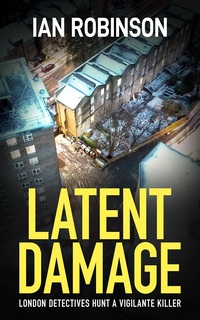 |
Latent Damageby Ian Robinson Kindle Edition, 199 pg. Read: February 16-17, 2021 |

What’s Latent Damage About?
Being awakened at 5 in the morning on a Saturday morning to come to a crime scene is not what DS Nick Moretti had planned. He’s got a vacation—sorry, holiday—coming up in a couple of weeks, and a homicide investigation could derail that. All part of the fun in the Met’s Homicide and Serious Crime Command.
When he arrives at the crime scene, Moretti discovers that the victim is a Muslim man whose throat was cut just across the street from his mosque. Automatically, the assumption is this is some sort of right-wing group acting out Anti-Muslim sentiment.
Moretti’s DI, Pip Nash spent some time in an undercover unit and still has a lot of contacts there—she’s able to use some of them to help once they get a direction to look in, but first they need to get a motive and some suspects.
While they’re still struggling to get some momentum for the investigation, another body shows up—with his throat cut in a similar fashion—this time, however, it’s an Anglican priest who was the victim.
Now, the team has two members of religious communities murdered in December—this is a PR nightmare in the making for the Met. Will these detectives and the rest of their team be able to stop the killer before another corpse shows up?
DI Nash and DS Moretti
DI Pip Nash is career-oriented, by the book type. She knows what she wants out of members of her team and isn’t afraid to demand it. Her background with the UC team adds a fun twist to things, and watching both the informants’ team and the UC team work with the homicide team is a nice change of pace—I’m used to seeing one of these entities at work, watching them cooperate (to whatever degree) is a great way to start a series.
DS Nick Moretti is less career-oriented (it seems), he’s definitely less by the book (he’s lucky if his alarm gets set in the morning). But he seems to do a good job of rallying the troops and putting the pieces of the murder together. His personal life is in an interesting state (although he has one, and it doesn’t seem that Nash does), and seems like it will prove fertile ground for drama in the future.
I’ve seen versions of both of these characters in books here and there—rarely as a team sharing the name of the series. I think watching their dynamic grow and develop over the next few books will prove just as interesting (maybe more so) than the crimes they investigate.
A Couple of Misgivings
So much of the dialogue in this book was awkward—some was even painful. The characters were trying to joke around or banter and it came off as stilted or excessively wordy—and it’s just off-putting. There were also a few instances of “I’m going to explain my job duties as I carry them out, despite the fact that everyone I’m talking to already knows this is my job.” The latter happens a lot with procedurals, so it’s easy to shrug off (even if these were some egregious examples). The former, however, is another matter. These are supposed to be friends or at least close colleagues, banter should feel natural. I’m going to chalk this up to Robigins just getting used to this world, and (if you count the works under his pen name) this is at least his fifth novel, and the first that I know of where practically every character wasn’t lying to everyone they talk to—it’s possible he doesn’t know how to write for people who aren’t deceiving.
So, what did I think about Latent Damage?
One thing that I’ve always really enjoyed about a good police procedural is the procedure. Watching a team go through the steps, grinding away to get the desired result is a pleasure. Sure, the procedure is dramatized, and usually only bears a passing resemblance to reality. But you can generally get a feel for what authors skew toward authenticity (few of these would be U.S.-based procedurals). And that’s pretty much what Robinson gives us—naturally, that’s helped by his years of actual experience. As such, there are investigative paths that go nowhere, and some that lead to unexpected places—and the amount of effort that goes into making small progress is a great realistic touch.
Yes, the ultimate reveals about the way the killer went about things seems a bit on the outlandish side*—but the way the team came up with his identity wasn’t. Nor was his motive, which seemed very grounded in reality.
* not unforgivably so, I’m not reading True Crime here, I don’t want a dramatized police blotter.
This is a solid, entertaining novel with a few stumbles along the way. But I’m recommending it, and am planning on coming back for at least a couple of more installments in this new series. Nash and Moretti are both the kind of characters you could build a series around, put them together and you’ve got a great foundation; the procedural element was well done, and the ending was as satisfying as you could ask for. Also, under his pen name, Robinson has crafted some of the best Crime Writing of the last few years—this series is going to improve, I know it (and even if it stayed at the same level, it’d still be worth coming back for).

![]()


1 Pingback